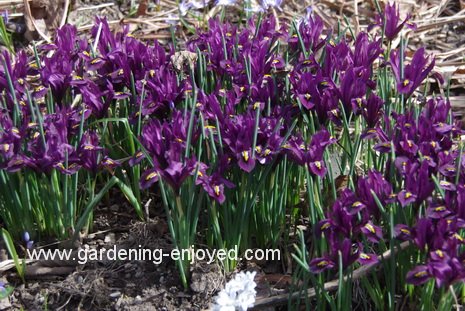
They are collectively known as minor bulbs but in the early spring their presence and effect is anything but minor. These Bulbous Iris, J.S.Dyt, are among that group and they make a solid wall of colour in my garden at this time of year. They are usually inexpensive allowing us to plant a good sized area. These Iris like many of those small bulbs spread over the years to provide a solid cover and yet by early summer most of their foliage has disappeared leaving room for something else to take over. That's a Puschkinia in the foreground. There is an even bigger area of pink Chionodoxa in the back garden and of course there are scilla that were once planted in the front lawn, now covering ever larger areas throughout the yard, they are almost a nuisance. Watch for several of these little gems in the fall and plant them in random spots throughout your garden.
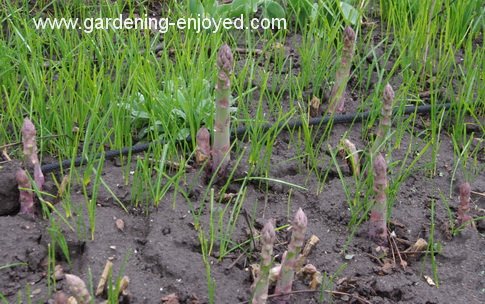
Much excitement abounds in this vegetable loving house when this happens. The first Asparagus shoots pop out of the cool spring soil to announce that both spring and the vegetable garden season have well and truly arrived. It is at least two weeks early this year. Eating Asparagus in April is an unusual treat. The picture was carefully taken to show the mass of grass like foliage that seems to be invading the Asparagus bed. It is actually the leaves of the Autumn Crocus that has been spreading through this bed for years. If we ignore it, they will disappear by early summer and reward us with those lovely purple flowers in early October. This is a real three season bed as the Iris and Daylilies will enjoy the company of the Asparagus fern all summer.
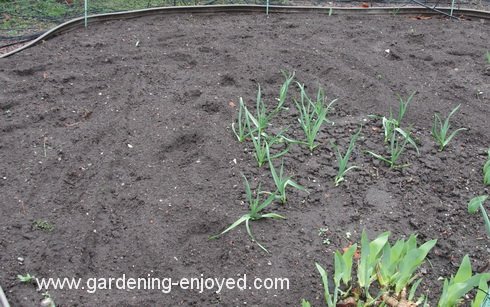
A bed filled with lovely rich, fluffy and weed free soil looks inviting and is just asking for some seeds. The bed has just been rototilled, again it’s about 2 weeks early. Getting the rototiller out of the garage always creates a bit of a horticultural dilemma. There is lots of evidence to suggest that rototilling needlessly disturbs the soil and its complex web of microorganisms thereby reducing soil health. I have spent an hour or more in the spring carefully hoeing this bed to remove the early spring weed growth while trying to disturb the soil as little as possible. The problem is the root vegetables. They do so much better in deeply prepared soil and that’s what I tend to plant in these beds. Having tried both ways a number of times, I find myself returning to the rototiller to try and make life easier for the Carrots, Beets and Potatoes and just incidentally saving my back from those couple of hours of hoeing. That’s the Garlic that we carefully
avoided.
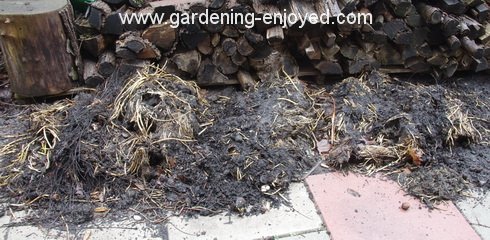
Last week I showed you a picture of the half empty pond that I was about to clean out. I can report that I survived that experience, just. It took a few hours with a pruning saw to cut through the massive woody stems of the Water Lilies. This huge pile of stems and roots is what came out of that pond. It’s spread out here in the hopes of drying it out so that I can shovel it into the brown paper bags that we use for our municipal garden waste collection. I’ll have to make sure I have enough bags because I won’t be able to put too much in each one and still be able to carry it to the curb. Even dry, those solid stems and extensive roots will still be quite heavy. I have restarted some of those Lilies both in a container and with one piece loose on the bottom of the pond. There is one more pond that will need the same treatment but my body is suggesting that this autumn or next spring might be a better time to tackle that chore.
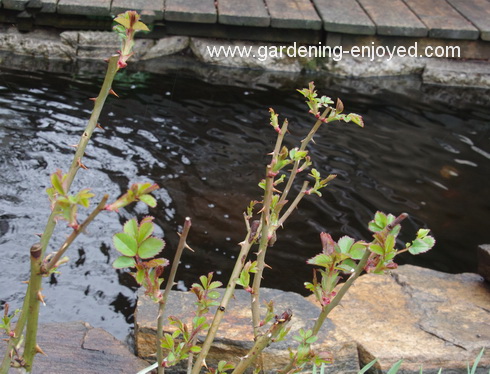 Here is the promise of some early summer delights, hopefully made better by my efforts. I showed you the emerging Rose buds last week and I spent some time this week pruning those Roses. I take my secateurs and one of those brown bags and methodically visit each Rose in the garden. The bag is used because I don’t put Rose prunings in my compost where they tend NOT to compost and then bite me next year when I am working with that compost. Most of the Roses survived the winter very well this year and are promising a beautiful flush of blooms. My pruning consists of choosing a few of the strongest canes and cutting them back to leave just a few healthy buds. The actual cut is made just above a bud that is growing well and is headed outwards from the bush, hopefully creating a nice open and spreading plant. All of the spindly canes that may have started to grow last year are cut out unless I need one to
develop to make a better shaped bush. I usually get reminded to put my leather gloves on by the first thorn that draws blood. Careful can never replace gloves!
Here is the promise of some early summer delights, hopefully made better by my efforts. I showed you the emerging Rose buds last week and I spent some time this week pruning those Roses. I take my secateurs and one of those brown bags and methodically visit each Rose in the garden. The bag is used because I don’t put Rose prunings in my compost where they tend NOT to compost and then bite me next year when I am working with that compost. Most of the Roses survived the winter very well this year and are promising a beautiful flush of blooms. My pruning consists of choosing a few of the strongest canes and cutting them back to leave just a few healthy buds. The actual cut is made just above a bud that is growing well and is headed outwards from the bush, hopefully creating a nice open and spreading plant. All of the spindly canes that may have started to grow last year are cut out unless I need one to
develop to make a better shaped bush. I usually get reminded to put my leather gloves on by the first thorn that draws blood. Careful can never replace gloves!
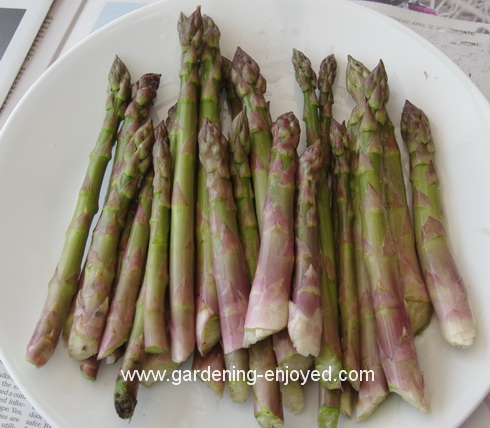
LAST NIGHT’S DINNER:-)
To ask a question just “reply” to this ezine. Don’t forget to check the front page of the Website for frequent short ideas for current gardening activities.
Darlene Asks? My Peony has been in this location for years, giving me beautiful flowers each year. Last year it budded, than nothing. Do you have any suggestions on what l can do, so this isn't repeated this year. Noticed yesterday it's starting to break ground, and l am encouraged that maybe with some advice from you l could have flowers again.
Ken Answers! If the buds appeared and then did not develop, it’s possible that they were damaged by a late hard frost. Peonies usually are quite hardy but strange things can happen. Peonies don’t like to be planted too deep and as you didn’t transplant it, did you add a layer of mulch over the
crown?
Linda Asks? I would like to divide my Primrose (Primula) and also start some new plants from some leaf cuttings. When would the best time to do this be. I live in a zone between 5B and 6a. In the Finger Lakes area of New York. I can find videos on division, but not on starting new plants from leaves as well. I would like to try this as well.
Ken Answers! Division is easy and now is a good time. Never tried leaf propagation on Primulas but found this that may be some help. https://americanprimrosesociety.org/primula-101/leaf/ Good luck
Kathryn Asks? I was interested in what you said about your water lilies going into your pond containerless. Does your pond have a liner? Our pond is approx. 9x14 and 2ft deep. We have water lilies in the pond in pots and they do stay in over the winter but was wondering if they would grow and bloom better if not confined.
Ken Answers!Some need an anchor and
if they are big enough I just put a good sized rock on them. Some are quite happy being loose and tend to sink. I've never seen any damage to the liner and I think my ponds are about 20 years old.
|

 Here is the promise of some early summer delights, hopefully made better by my efforts. I showed you the emerging Rose buds last week and I spent some time this week pruning those Roses. I take my secateurs and one of those brown bags and methodically visit each Rose in the garden. The bag is used because I don’t put Rose prunings in my compost where they tend NOT to compost and then bite me next year when I am working with that compost. Most of the Roses survived the winter very well this year and are promising a beautiful flush of blooms. My pruning consists of choosing a few of the strongest canes and cutting them back to leave just a few healthy buds. The actual cut is made just above a bud that is growing well and is headed outwards from the bush, hopefully creating a nice open and spreading plant. All of the spindly canes that may have started to grow last year are cut out unless I need one to
develop to make a better shaped bush. I usually get reminded to put my leather gloves on by the first thorn that draws blood. Careful can never replace gloves!
Here is the promise of some early summer delights, hopefully made better by my efforts. I showed you the emerging Rose buds last week and I spent some time this week pruning those Roses. I take my secateurs and one of those brown bags and methodically visit each Rose in the garden. The bag is used because I don’t put Rose prunings in my compost where they tend NOT to compost and then bite me next year when I am working with that compost. Most of the Roses survived the winter very well this year and are promising a beautiful flush of blooms. My pruning consists of choosing a few of the strongest canes and cutting them back to leave just a few healthy buds. The actual cut is made just above a bud that is growing well and is headed outwards from the bush, hopefully creating a nice open and spreading plant. All of the spindly canes that may have started to grow last year are cut out unless I need one to
develop to make a better shaped bush. I usually get reminded to put my leather gloves on by the first thorn that draws blood. Careful can never replace gloves!



